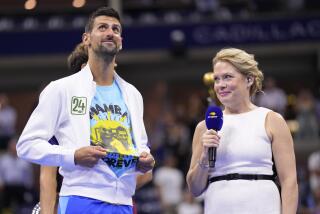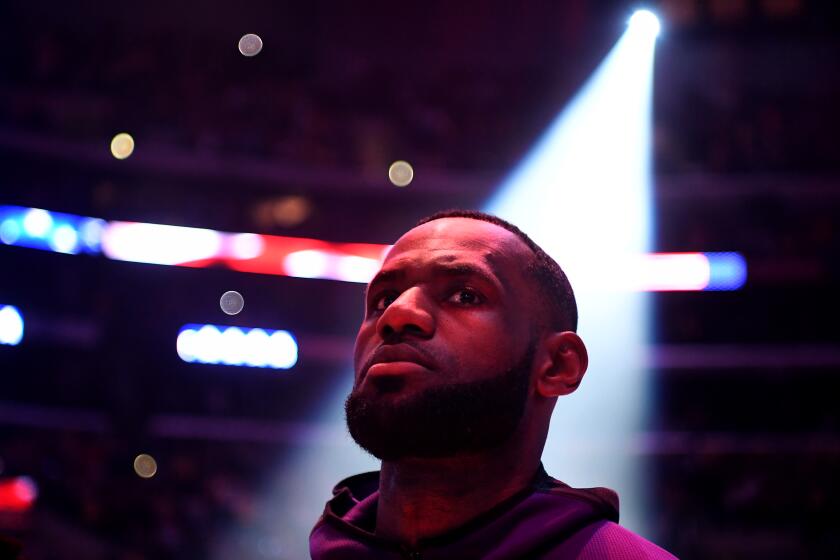Players bring the drama to the U.S. Open
- Share via
Once again, the U.S. Open should be on a nomination list for best ongoing drama performance. Forget the Emmys, Oscars and ESPYs. Just retire the trophy.
Monday’s four-set, mind-blowing men’s final, building to a crescendo over 4 hours and 10 minutes as if Shakespeare had a role in the script, was only the final act.
When Novak Djokovic cranked his winning shot on match point, defeating defending champion Rafael Nadal, it completed 15 days of a rollercoaster ride that few other sporting events can offer. OK, make that 13 days, because two were rained out and that triggered more controversy and angst over everything from player scheduling to television’s power to dictate.
If you go to the U.S. Open looking for story lines and can’t find any, you are legally dead. Even from 3,000 miles away, they are right in your face.
When Djokovic won, it marked the sixth straight time he had defeated Nadal. In six finals. Tennis players don’t have careers like that, much less seasons. With what he has done this year — three major titles, a 64-2 record so far, a 40-1 mark on hard courts — Djokovic would be Joe DiMaggio if he were a baseball player.
Hitting safely in 56 straight games is not possible. Neither is winning the U.S. Open by dismantling the previously indestructible Nadal, and doing so two days after coming back from two sets against the pre-Nadal previously indestructible. When he smashed that winning forehand return in the semifinals against Roger Federer, who was serving on match point, it should have been obvious to tennis fans everywhere that poor Nadal would probably be toast again in a final.
And he was, so remarkably so that, in a fourth set that began with Djokovic courtside on his stomach and having his sore back attended to minutes after Nadal had won a dramatic third-set tiebreaker, the prototype fighter seemed to lose his fight.
Because of his back, Djokovic couldn’t hit serves at his usual 120 mile-an-hour pace, but Nadal seemed incapable of turning that into a difference-maker. Djokovic won the final set, 6-1.
In his post-match turn at the microphone, Nadal was his usual charming self, and assured everybody he had tried his best. Nobody would question that. His 10 Grand Slam titles and his chase-down-everything style of play are proof enough.
But in this one, the wounded Djokovic dished out all the hurt to the willing warrior in the last set. Shots that would be chased down by Nadal and somehow pushed back were allowed to go uncontested. Perhaps, after you’ve seen this same movie five times previously in just seven months, you run out of ideas as to how to change the ending.
After he beat Andy Murray in the semifinals Saturday, Nadal had made one of his broken English statements that, taken literally, would represent his prediction of Monday’s final with Djokovic.
Nadal said, “This year, I have lost the last five matches against him. Five finals. This will be the sixth.”
The competitive quality of this match, until Nadal’s fade at the end, was stunning. To have 24-to-26-stroke rallies was not uncommon. Decent club players watching had to marvel at how one rally could produce seven or eight shots that would be lifetime treasures for them. The most surprising thing was that, when Djokovic and Nadal got done, there was any paint on the lines at all.
Broadcaster Dick Enberg summed up things nicely at one point.
“This is scintillating stuff,” he said.
There was one 18-minute game. The chair umpire warned each about playing too slowly. (Did he ponder the damage of oxygen deprivation?). There were complaints about glare from the suite windows. The New York fans, many of whom missed the memo on not yelling during a player’s service toss, kept it loud and raucous. Never a dull moment.
And, of course, all this was happening against the emotional backdrop of the 10-year anniversary of 9/11, and all its accompanying ceremonies in the city most affected on that day.
Before they even started, the telecast needed to deal with the news in the aftermath of the messy little incident in Sunday’s women’s final. In that one, Serena Williams reacted to a chair umpire’s point reversal by telling her not to look at her and, a bit later, saying, “I hate you.”
The U.S. Tennis Assn., which turns into Fort Knox every year during this two-week event, continued its tradition of wimpy, tip-toe-around-it discipline, fining Williams $2,000 and saying this was in line with what it has done in similar situations. So, the door is now open for the other players, all of whom have a spare $2,000 around, to threaten and tell chair umpires they hate them. Precedent is precedent.
There was no immediate report on which old purse Williams would dig through for loose change to pay the fine.
Mary Carillo, in the network broadcast booth with Enberg and John McEnroe, commented on the fine as follows:
“Give me a break.”
McEnroe, who had his share of run-ins with officials as a player, said, “I wish I were around playing now. They pay more and they fine less.”
So, another U.S. Open tennis tournament is in the books. At the beginning, it had a hurricane threat. Near the end, it had a threat to a chair umpire. And on its final day, it had a match that threatens to redefine forever both shot-making and players’ competitive heart.
It’s off Broadway, but what a show.
Dwyre reported from Los Angeles.
More to Read
Go beyond the scoreboard
Get the latest on L.A.'s teams in the daily Sports Report newsletter.
You may occasionally receive promotional content from the Los Angeles Times.











